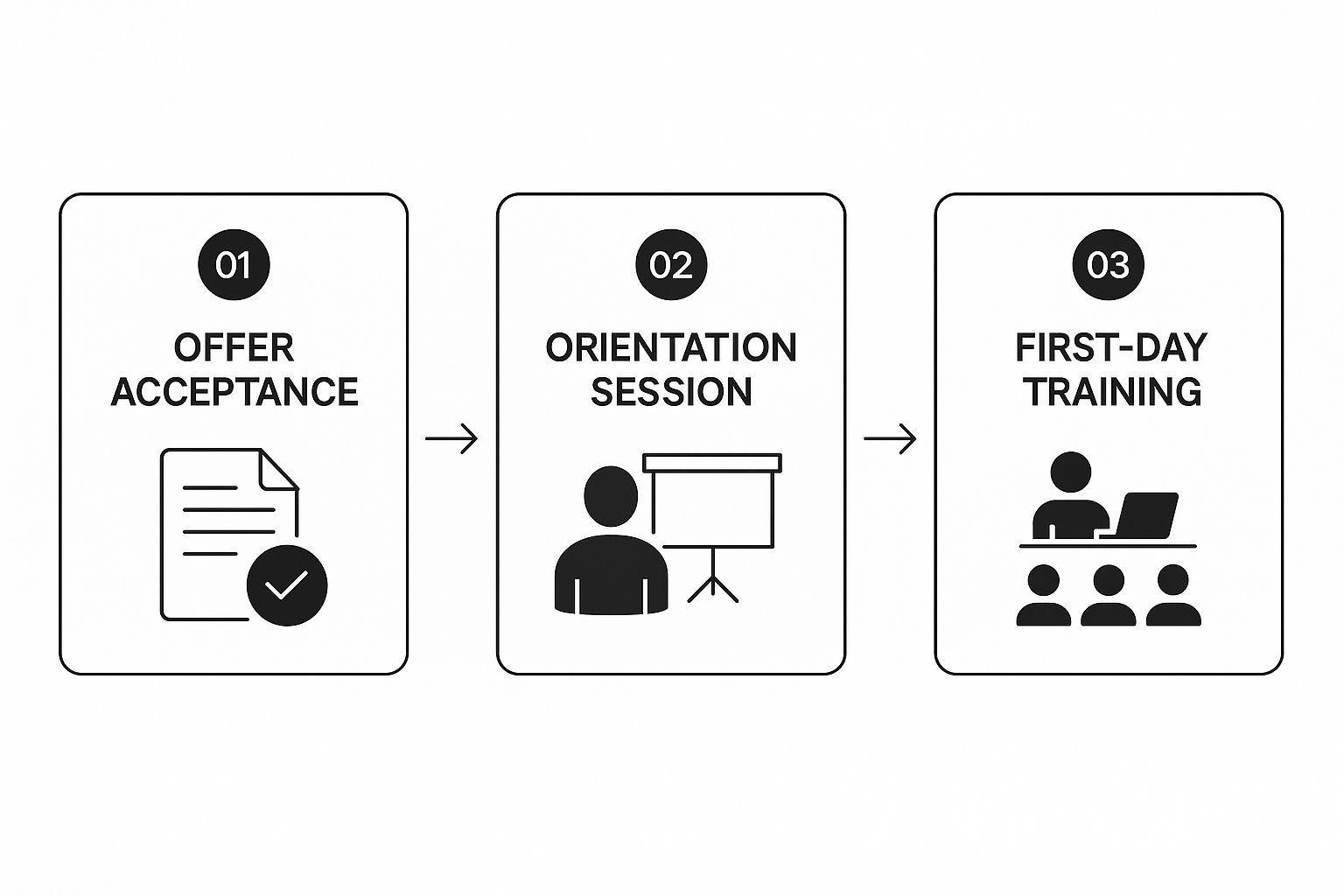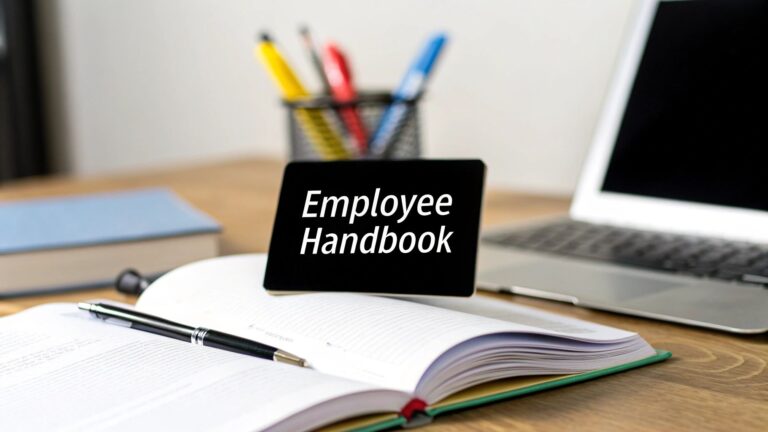A small business employee handbook is one of those foundational documents that really sets the stage for your company. It lays out your mission, policies, procedures, and expectations—basically, making sure everyone is operating from the same playbook.
Think of it as more than just a rulebook. It’s your first line of defense against legal headaches and a key tool for building the kind of positive, consistent company culture you want from day one.
Why Your Handbook Is More Than Just a Document

So many small business owners I've worked with push creating an employee handbook to the "later" pile. It's a task for when the company is bigger or more established, right? Honestly, this is a common and often costly mistake.
A well-crafted handbook isn't just bureaucratic paperwork; it’s a strategic asset that provides clarity, consistency, and crucial legal protection from the moment you hire your first employee. It's the operating system for your team.
Without it, employees are left guessing about everything from PTO requests to what’s okay to post on social media. That ambiguity almost always leads to inconsistent enforcement, feelings of favoritism, and HR headaches you just don't need.
Setting Clear and Consistent Expectations
A handbook simply removes the guesswork. It clearly defines what you expect from your team and, just as importantly, what they can expect from you. This creates a fair and transparent environment where everyone understands the rules of the game.
Take something like overtime. A clear policy prevents disputes over paychecks. Instead of a casual "just get it done," the handbook can specify:
- Practical Example: "All overtime must be pre-approved in writing by your direct manager. Unapproved overtime will not be paid."
- Insight: Clearly stating how overtime is calculated (e.g., "at 1.5 times the regular hourly rate for all hours worked over 40 in a workweek") prevents payroll confusion.
- Process: Detailing the exact process, such as submitting approved hours through a specific payroll software by the end of the pay period, ensures consistency.
This level of detail ensures everyone is treated the same, which goes a long way in building trust. It even helps protect your online presence; clear social media guidelines can safeguard your brand’s image. Protecting your digital footprint is a critical topic we cover in our guide to small business online reputation management.
Your First Line of Legal Defense
From a legal standpoint, a small business employee handbook is your most important shield. It proves you’ve established and communicated fair, compliant policies to your entire team. This is especially vital in "at-will" employment states.
Here’s a quick look at the at-will employment doctrine, which is a concept you’ll absolutely want to define in your handbook.

Basically, at-will employment allows either the employer or the employee to end the relationship at any time, for any reason not prohibited by law. Your handbook needs to state this clearly while also outlining your commitment to non-discrimination.
Despite its importance, a shocking number of small businesses don't have this protection. Research shows that only about 26% of businesses with fewer than 10 employees have a formal handbook. That’s a huge risk, especially when you consider that the median cost of an employment lawsuit that goes to trial is around $88,000—a sum that could easily cripple a small company.
Practical Insight: A handbook is your evidence. If an employee ever claims they were unaware of a policy—for instance, a safety rule they violated—their signed acknowledgment of the handbook becomes your primary defense, proving the rules were clearly communicated.
Ultimately, investing time in a comprehensive handbook is an investment in your company's stability and future. It elevates your business from relying on informal, inconsistent verbal agreements to operating with professional, documented standards.
Crafting Your Handbook's Essential Policies
Now that you understand why you need a handbook, it's time to dig into the core of it: the policies. This is where you turn your company culture and legal duties into clear, practical guidelines for your team. The aim isn't to draft a dense legal tome that gathers dust, but to create a go-to guide that actually helps people.
A classic mistake is grabbing a generic template and just doing a find-and-replace with your company name. That approach completely misses the point. Your introduction, for example, should be a genuine welcome, not a sterile disclaimer. It’s your first chance to state your mission and frame the handbook as a resource for everyone's success.
Start With The Foundational Pillars
Every good handbook is built on a few non-negotiable policies. These aren't just suggestions; they're critical for legal compliance and setting a professional standard from day one. Think of them as the steel frame of your entire document.
First up, you need a crystal-clear Equal Employment Opportunity (EEO) statement. This is more than just a legal checkbox. It's a bold declaration that you're committed to a fair workplace and won't discriminate based on protected characteristics like race, religion, gender, age, or disability.
Right after that, include an at-will employment clause. This policy clarifies that either you or the employee can end the employment relationship at any time, for any legal reason. It's a crucial legal shield for your business, particularly in at-will states.
Practical Insight: Don't DIY this part. Have a qualified employment lawyer look over your EEO and at-will statements. For example, some states have specific protected classes (like marital status or political affiliation) that go beyond federal law, and your lawyer will ensure your wording is compliant for your location.
Defining Conduct and Communication
With the legal cornerstones set, you can shift focus to the day-to-day stuff. These policies are all about guiding behavior, preventing confusion, and making sure everyone feels respected at work. This is where you really define what professionalism looks like at your company.
A general Code of Conduct is the perfect place to start. This section outlines your baseline expectations for professional behavior—think dress code, attendance, and how to interact respectfully with coworkers and clients. It tells everyone what it means to be part of the team.
Next, you have to tackle communication, especially in the digital world. A modern handbook needs a social media policy, but it has to be specific. A vague warning to "be professional online" is useless. Give clear examples:
- Do (Practical Example): Disclose your employment with the company when discussing work-related topics, and include a disclaimer like "opinions are my own."
- Don't (Practical Example): Post photos of client worksites or internal company documents without explicit permission.
This kind of clarity protects your brand's reputation without making employees feel like they’re being watched 24/7. Your handbook should also clearly define your approach to an effective performance management system, which sets clear expectations for reviews, feedback, and growth.
This is how a handbook becomes a tool for building a better business. In fact, small businesses that keep their handbooks updated are about one-third more likely to experience business growth than those that don't. It shows that clear policies create a stable, professional culture that helps you keep great people.
Structuring Pay and Benefits Policies
Finally, your handbook needs to be completely transparent about compensation and benefits. People will refer to these sections constantly, so there's no room for ambiguity. Vague policies on pay or time off are a fast track to frustration and bad morale.
Your compensation section should break down:
- Pay Schedules: When do people get paid? How are checks delivered? For example: "Payday is every other Friday. Direct deposits are processed for delivery on that day."
- Timekeeping: How do employees track their hours? What’s the process for fixing a mistake? For example: "All hourly employees must clock in and out using the [Software Name] app. Any corrections must be submitted to your manager by 5 PM on Thursday of a pay week."
- Overtime: Who qualifies? How is it approved and calculated?
Be just as direct with your benefits. Your Paid Time Off (PTO) policy needs to explain how time is earned, the process for requesting it, and any blackout dates. If you offer health insurance or a retirement plan, give a solid overview and then point people to the official plan documents for the nitty-gritty details.
To help you decide what to include, it's useful to think about which policies are absolute must-haves versus which ones are best practices.
Essential vs. Recommended Handbook Policies
Not all policies carry the same weight. Some are legally required to protect your business, while others are smart additions that help create a positive and efficient workplace. Here’s a breakdown to help you prioritize.
| Policy Category | Must-Have Policies (Legal Essentials) | Recommended Policies (Best Practices) |
|---|---|---|
| Foundational | Equal Employment Opportunity (EEO) Statement, At-Will Employment Clause, Anti-Harassment & Discrimination | Welcome Letter/Mission Statement, Company History, Open Door Policy |
| Conduct | Code of Conduct (general behavior), Workplace Safety Rules | Social Media Policy, Dress Code, Attendance & Punctuality, Confidentiality Agreement |
| Compensation | Pay Schedules & Timekeeping, Overtime Policy (for non-exempt employees) | Expense Reimbursement, Performance Review Process, Bonus/Commission Structures |
| Benefits & Leave | Legally Mandated Leaves (FMLA, Jury Duty, Military), Workers' Compensation Info | Paid Time Off (PTO)/Vacation, Sick Leave, Holiday Schedule, Health Insurance Overview |
| Technology | Use of Company Equipment | Bring Your Own Device (BYOD) Policy, Remote Work/Telecommuting Policy, Information Security |
This table should give you a clear roadmap. Start with the "Must-Haves" to ensure you're compliant, then build out the "Recommended" policies to create a handbook that truly reflects your company culture and sets your team up for success.
The infographic below shows the typical journey for a new hire—a process that is made smoother and more consistent by the very policies you're putting in place.

This flow from offer to training shows how a well-crafted handbook provides a reliable source of information at every critical stage. By putting in the effort to create these essential policies, you're not just writing down rules—you're building a fair and dependable framework for your entire team.
Navigating Critical Legal and Compliance Issues

While your handbook is great for setting the cultural tone, let's be blunt: its most important job is to be your legal shield. A single, poorly worded policy can open your business up to a world of liability. This is where precision is everything. The difference between a compliant phrase and a non-compliant one can be subtle, but the consequences are huge.
For a small business, trying to keep up with the tangled web of federal, state, and local labor laws can feel like a full-time job. These regulations are constantly shifting. That’s why your small business employee handbook has to be a living document, always reflecting the current legal standards if you want it to be worth the paper it's printed on.
Demystifying Core Compliance Areas
Let's get into the weeds a bit. Certain policies carry a lot more legal weight because they're directly tied to specific employment laws. These are the areas where business owners most often trip up, leading to costly lawsuits, audits, and fines from agencies like the Department of Labor.
Here are a few of the high-stakes policies that cause the most headaches:
- Overtime and Wage Laws: The Fair Labor Standards Act (FLSA) is notoriously complex. Your handbook must clearly define how you classify employees (exempt vs. non-exempt) and spell out your exact process for calculating and approving overtime. Practical Example: "Non-exempt employees are eligible for overtime. Exempt employees, such as salaried managers, are not." This simple distinction is legally vital.
- Meal and Rest Breaks: Many states have incredibly strict rules about when and how employees take breaks. Practical Example (California): "Employees are entitled to a 30-minute unpaid, duty-free meal break if they work more than 5 hours, and a 10-minute paid rest break for every 4 hours worked." You need to spell out your state's specific requirements.
- Leave Policies: Laws like the Family and Medical Leave Act (FMLA) and the Americans with Disabilities Act (ADA) have very specific requirements. Even if your business is too small for FMLA to apply (it typically requires 50 or more employees), you might be surprised to find that state or local leave laws still cover you.
These aren't the places to get creative. They demand clear, compliant language that leaves zero room for misinterpretation.
The Power of Precise Language
Let's take anti-harassment policies as a perfect example. A weak, generic statement like, "We do not tolerate harassment," offers almost no legal protection. It’s too broad and, crucially, doesn't tell an employee what to do if they see or experience a problem.
A strong, defensible policy is specific and actionable. It should:
- Define harassment clearly: Practical Example: "Harassment includes, but is not limited to, unwelcome jokes, slurs, epithets, threats, or physical contact related to a person's race, gender, or other protected characteristic."
- Establish a clear reporting procedure: Practical Example: "You can report any incidents to your direct manager, the HR department, or the company owner. If your manager is involved, please report it directly to one of the other named contacts."
- Guarantee non-retaliation: State in no uncertain terms that the company will not punish anyone for making a good-faith report.
Crucial Insight: Vague policies create legal exposure. Precise, actionable policies create a protective shield for your business and a safe environment for your team.
This need for precision carries over to health and safety. Your handbook needs to show your commitment to a safe workplace. It’s not just about meeting general requirements; it's about aligning your policies with specific regulations, like those found in an ultimate OSHA compliance checklist. This is absolutely essential for protecting both your employees and your business.
Essential Disclaimers You Cannot Skip
Finally, there are a few key disclaimers you absolutely must include to protect the handbook's legal standing. These statements clarify the document's purpose and prevent it from being misinterpreted as a binding contract.
The most critical of these is the at-will employment statement, which we mentioned earlier. It reinforces that either the employee or the company can end the employment relationship at any time, for any lawful reason. This is a foundational protection you can't afford to miss.
Another vital piece is the "not a contract" disclaimer. This explicitly states that the handbook is a set of guidelines, not an employment contract. Practical Insight: This disclaimer helps prevent a situation where a terminated employee might argue that the handbook's disciplinary steps (e.g., verbal warning, written warning, etc.) created a binding contract that you violated.
For business owners focused on reaching their local community, understanding these legal nuances is just as important as your outreach strategy. Our guide on local marketing for small business can help you grow your customer base while you ensure your internal policies are solid.
Getting these legal and compliance issues right transforms your handbook from a simple rulebook into one of your most valuable risk management tools. It’s a proactive step that shows you're serious about operating fairly and legally.
Adapting Policies for Remote and Hybrid Teams
The classic nine-to-five in a central office just isn't the only game in town anymore. With teams now spread across different cities and time zones, your small business employee handbook has to catch up to the realities of remote and hybrid work. If you just try to apply old, office-first rules to a distributed team, you're setting yourself up for a mess of confusion and disengagement.
This isn't just a temporary trend; it’s a fundamental shift in how we get work done. The latest numbers show that about 12.7% of full-time employees are now fully remote, with another 28.2% on a hybrid schedule. That’s a huge chunk of the workforce, and it’s exactly why a modern handbook is so critical for setting clear, consistent expectations—no matter where someone is logging in from. You can discover more insights about employee handbook importance from industry experts to dig deeper into these workforce shifts.
A well-crafted handbook becomes your single source of truth, creating a level playing field for both your in-office and remote folks. It’s all about answering the practical questions that pop up the moment someone’s home is their office.
Setting Clear Communication Expectations
When you can't just stroll over to someone's desk, the rules of communication become mission-critical. Without clear guidelines, you’ll either end up with a culture of constant interruptions or, just as bad, team members feeling totally isolated and out of the loop. Your handbook needs to spell out exactly how and when your team connects.
This means getting specific about:
- Core Availability Hours: Practical Example: "All team members are expected to be online and available for meetings and quick chats between 10 AM and 3 PM ET to accommodate different time zones." This respects flexibility while ensuring collaboration.
- Response Time Guidelines: Practical Example: "Acknowledge direct messages on Slack within two hours during the workday. For non-urgent email, a response within 24 hours is expected." This prevents anxiety and keeps things moving.
- Primary Communication Channels: Practical Example: "Urgent questions go in Slack. Formal updates and client communication happen via email. All project-specific discussions should be kept within Asana." This simple step stops important information from getting lost.
Securing Data Beyond the Office Walls
Data security isn't just about locking the office doors and protecting your internal network anymore. With employees working from home, your company’s sensitive information is being accessed from countless different Wi-Fi networks. Your handbook absolutely must include a straightforward remote work security policy.
This policy should mandate some basic security hygiene that anyone can follow. You're not trying to turn everyone into an IT expert, just establish a baseline. Key points should include things like requiring employees to use a secure, password-protected home Wi-Fi network and always using a company-provided VPN to access company systems. It’s also smart to outline the procedure for immediately reporting a lost or stolen company device to get ahead of any potential data breaches.
Practical Insight: Your remote work policy isn't just a list of rules; it's about extending your company’s circle of trust and security to each employee's home office. A good policy might state, "Company devices may not be used by non-employees, including family members, to prevent accidental data exposure."
Creating Fair Home Office and Expense Policies
One of the trickiest areas to navigate with remote teams is handling expenses. Your people are going to have questions about who pays for what, and a clear, upfront reimbursement policy prevents any feelings of resentment and makes sure everyone is treated fairly.
A simple and effective approach is to offer a monthly stipend for home office expenses. For example, providing a $50 monthly stipend to cover internet and other utilities is a common and fair practice. For bigger, one-time purchases like an ergonomic chair or an external monitor, you should set up a pre-approval process. This way, employees can submit a request before buying, giving you control over costs while helping your team build a comfortable and productive workspace.
By proactively addressing these remote-specific issues right in your handbook, you’re building a strong framework that truly supports a distributed team. It's how you create a cohesive, efficient, and positive culture, even when your team is miles apart.
Putting Your Handbook Into Practice

Creating a comprehensive small business employee handbook is a massive accomplishment—congratulations. But the document itself is only half the battle. Its real value comes from how you bring it to life in your company’s day-to-day operations.
Let’s be honest: a handbook that just sits in a digital folder is as useless as having no handbook at all.
The rollout is your chance to frame this document in the right light. This isn’t just a list of rules and restrictions. Think of it as a guide designed to ensure fairness, clarity, and success for everyone on the team. Your goal is to make it a living, breathing part of your business culture.
Distributing Your Handbook Effectively
How you share the handbook sets the tone for its importance. While you could print out stacks of paper, a digital-first approach is almost always the smarter move for a small business. It’s far more efficient, a breeze to update, and creates a clean record of who has it.
Consider using a secure cloud-based platform or your HR information system (HRIS) to host the document. This makes it instantly accessible whether your team is in the office or working from a coffee shop. Simply emailing it as a PDF works, too, but make sure you have a solid system for tracking receipt.
No matter which method you choose, one step is absolutely non-negotiable: every single employee must sign an acknowledgment form.
Practical Insight: This signed form is your proof that an employee has received the handbook, understands its contents, and agrees to abide by the policies. In a legal dispute over a termination, this document can be the centerpiece of your defense, proving the employee was aware of the policy they violated. Keep these signed forms locked down securely in each employee's personnel file.
Introducing the Handbook with a Positive Frame
The initial announcement can make or break how your team sees the handbook. Whatever you do, avoid presenting it as a new set of rigid rules dropped from on high. Instead, get everyone together for a team meeting and introduce it as a valuable resource that benefits the whole crew.
Emphasize how it helps create a more transparent and consistent workplace. Frame it as a tool that answers common questions and ensures everyone is treated fairly.
You could say something like:
- "We put this guide together to make sure we're all on the same page about important stuff like PTO and our company values. No more guessing!"
- "This handbook is here to protect both you and the company by outlining clear, fair processes for everyone. It's about consistency."
This kind of positive framing encourages employees to see it as a helpful reference rather than a disciplinary tool. It’s your opportunity to reinforce that these policies exist to support a healthy, productive, and respectful work environment.
Establishing a Regular Review Schedule
Your business will change. Employment laws will definitely evolve. Your handbook cannot be a "one-and-done" project. To keep it relevant and compliant, you have to commit to a regular review schedule. An annual review is the absolute minimum.
Set a calendar reminder each year to sit down and read through the entire document. Ask yourself a few key questions:
- Have any federal, state, or local laws changed? Practical Example: Did your city just pass a mandatory paid sick leave ordinance? If so, your old PTO policy is now out of compliance.
- Has our company culture or the way we work shifted? Practical Example: Maybe you've introduced a permanent hybrid work model that needs a formal policy outlining in-office days and expectations.
- Are any policies causing confusion or frustration? Practical Example: If you get five different questions about how to submit expense reports in one month, that's a clear sign the policy needs to be rewritten for clarity.
Because handbooks are living documents, implementing strong document version control is essential to manage updates and maintain compliance. Each time you revise the handbook, communicate the changes clearly to your team and—you guessed it—require them to sign a new acknowledgment form. This simple discipline ensures your handbook remains a powerful, protective, and practical asset for your business.
Common Handbook Questions Answered
Even with the best game plan, you're bound to hit a few roadblocks when putting together your first small business employee handbook. It's totally normal. Let's walk through some of the most common questions and sticking points I see business owners run into.
Getting these details right from the start will make your handbook a genuinely useful tool, not just another document collecting dust.
When Do I Actually Need an Employee Handbook?
The short answer? From your very first hire.
While there’s no magic number of employees that triggers a federal law requiring a handbook, having one from day one sets a professional tone. It establishes clear, foundational policies on conduct, pay, and safety before any bad habits or misunderstandings can take root.
Practical Insight: Imagine you hire your first employee and they ask about holidays. Without a handbook, you answer verbally. The second hire gets a slightly different answer. By the third hire, nobody is sure which holidays are paid. A handbook from day one prevents this inconsistency.
Yes, certain laws like the FMLA don't apply until you have 50 employees, but the real value of a handbook is protecting your business from common legal risks and miscommunications, no matter your size. It's so much easier to build this foundation early than to scramble and create one during a period of rapid growth or, even worse, in response to an HR crisis.
Can I Just Use a Handbook Template I Found Online?
Tempting, I know. But you should never, ever just copy and paste a template you found online. Think of a template as a great starting point—the raw clay, not the finished sculpture.
It gives you a solid structure to build from, but it won't account for your specific state and local laws, industry regulations, or the unique culture you're trying to build. A generic template is a recipe for compliance gaps.
Practical Example: A template might have a generic sick leave policy, but it won't include specific language required by paid sick leave laws in states like Colorado or cities like New York City. Using the generic version could put you in direct violation of local law.
Use it to get your first draft on paper, then customize it heavily to reflect how your business actually operates. Most importantly, always have a qualified HR professional or an employment attorney review the final version before you even think about distributing it.
Practical Insight: This final check by an expert is non-negotiable. An employment lawyer can spot language that might unintentionally create a contract (e.g., promising "permanent employment") and save you from massive headaches and legal fees down the road.
This professional review is one of the most effective strategies for protecting your business, much like a well-planned marketing effort protects your revenue. You can find more details about building strong business strategies in our article discussing how content marketing campaigns can benefit your business.
What Is the Best Way to Introduce a New Handbook?
How you roll out the handbook is just as important as what's in it. This isn't about dropping a rulebook on everyone's desk.
Frame it positively in a team meeting. Present it as a helpful resource designed to ensure fairness, clarity, and mutual success for everyone. It's a tool for alignment, not a list of restrictions.
The rollout itself should follow a few key steps:
- Digital Distribution: Share the handbook electronically through your HR platform or email. This makes it easy for everyone to access and ensures they always have the most current version.
- Signed Acknowledgment: This is the most critical part. Every single employee must sign an acknowledgment form confirming they've received it and understand its contents. That signature is your legal protection.
- Secure Storage: File those signed forms securely in each employee's personnel file, whether you keep physical or digital records.
And when you eventually update the handbook (which you will), communicate the changes clearly and explain why they were made. Practical Example: "We've updated our PTO policy to include a new floating holiday based on your feedback from our last team survey. Please review the updated section and sign the new acknowledgment by Friday." This transparency builds trust.
A well-structured handbook is a cornerstone of a well-run business, just like a smart marketing plan. At Latitude Park, we specialize in helping businesses like yours grow through targeted digital advertising and SEO. If you're ready to expand your reach, visit us at https://latitudepark.com.









